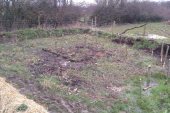
 2
2




Some places need to be wild
 7
7




Moderator, Treatment Free Beekeepers group on Facebook.
https://www.facebook.com/groups/treatmentfreebeekeepers/









Some places need to be wild

 1
1




Works at a residential alternative high school in the Himalayas SECMOL.org . "Back home" is Cape Cod, E Coast USA.
 2
2




A build too cool to miss:Mike's GreenhouseA great example:Joseph's Garden
All the soil info you'll ever need:
Redhawk's excellent soil-building series





 4
4




∞









Works at a residential alternative high school in the Himalayas SECMOL.org . "Back home" is Cape Cod, E Coast USA.




“Once a wise man told me, ‘Family don’t end in blood,’ but it doesn’t start there either. Family cares about you. Not what you can do for them. Family is there, for the good, bad, all of it. They got your back. Even when it hurts. That’s family.”




Some places need to be wild
 2
2




 3
3




Creating edible biodiversity and embracing everlasting abundance.
 1
1




 1
1




Creating edible biodiversity and embracing everlasting abundance.
 1
1




![Filename: BE59EC56-7A70-4DA6-B1D3-A7278B7350B8.jpeg
Description: Not my picture, found it online as a reference for planting willow sticks as reinforcement of banks. [Thumbnail for BE59EC56-7A70-4DA6-B1D3-A7278B7350B8.jpeg]](/t/135003/a/100601/BE59EC56-7A70-4DA6-B1D3-A7278B7350B8.jpeg)
 1
1




Creating edible biodiversity and embracing everlasting abundance.





|
What's brown and sticky? ... a stick. Or a tiny ad.
Learn Permaculture through a little hard work
https://wheaton-labs.com/bootcamp
|


